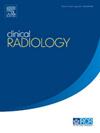Ultra-fast single-sequence magnetic resonance imaging (MRI) for lower back pain: diagnostic performance of a deep learning T2-Dixon pprotocol
IF 2.1
3区 医学
Q2 RADIOLOGY, NUCLEAR MEDICINE & MEDICAL IMAGING
引用次数: 0
Abstract
Background
Conventional magnetic resonance imaging (MRI) protocols for lower back pain require multiple sequences and long acquisition times, challenging healthcare systems amid rising demand for lumbar spine imaging.
AIM
To assess the diagnostic performance of an abbreviated, deep learning-accelerated sagittal T2w Dixon single sequence protocol (Protocolabb-DL) versus the standard lumbar spine MRI protocol (Protocolstd).
MATERIALS AND METHODS
In this prospective, single-centre study, 30 patients (mean age: 48 ± 18.5 years; 67% female) with lower back pain (LBP) underwent a single MRI examination using both Protocolstd (sagittal T1w and T2w turbo spin-echo sequences) and Protocolabb-DL. A senior radiologist (15 years experience) established the diagnostic reference standard using Protocolstd. Two independent readers (10 and 5 years’ experience) evaluated the images at a segmental level for degenerative pathologies, including Modic changes, disc pathology, facet arthropathy, neuroforaminal stenosis, and Schmorl nodes. Diagnostic performance, confidence, interprotocol, and interobserver agreements were analysed.
RESULTS
Protocolabb-DL reduced acquisition time by 80% at 1.5 Tesla (1:33 vs 7:43 minutes) and 84% at 3 Tesla (1:26 vs 8:43 minutes). Diagnostic performance was high, with sensitivities up to 100% [95% CI, 90.7–100.0] for Modic changes and 94.7% [95% CI, 87.1–98.5] for disc pathology, and specificities up to 100% [95% CI, 97.8–100.0] for Schmorl nodes. Diagnostic confidence was comparable between protocols (P > 0.05). Interprotocol agreement was excellent (κ: 0.84–1.00), and interobserver agreement for Protocolabb-DL was substantial to excellent (κ: 0.67–0.93).
CONCLUSION
Protocolabb-DL provides diagnostic performance comparable to Protocolstd for degenerative lumbar spine pathologies while reducing acquisition time by up to 84%.
下背部疼痛的超快速单序列磁共振成像(MRI):深度学习T2-Dixon方案的诊断性能
传统的下背痛磁共振成像(MRI)方案需要多个序列和较长的采集时间,在腰椎成像需求不断增长的情况下,这对医疗保健系统构成了挑战。目的:评估简化、深度学习加速矢状T2w Dixon单序列方案(protocol1b - dl)与标准腰椎MRI方案(Protocolstd)的诊断性能。材料和方法在这项前瞻性单中心研究中,30例患者(平均年龄:48±18.5岁;67%女性)腰痛(LBP)接受了单次MRI检查,同时使用了协议(矢状T1w和T2w涡轮自旋回波序列)和协议b- dl。一位资深放射科医生(15年经验)使用《方案》建立了诊断参考标准。两名独立的读者(分别有10年和5年的经验)在节段水平上评估图像的退行性病变,包括modc改变、椎间盘病理、小关节突关节病、椎间孔狭窄和Schmorl淋巴结。分析了诊断性能、置信度、协议间和观察者间的协议。结果协议abb- dl在1.5特斯拉(1:33 vs 7:43分钟)和3特斯拉(1:26 vs 8:43分钟)下分别减少80%和84%的采集时间。诊断性能高,对Modic病变的敏感性可达100% [95% CI, 90.7-100.0],对椎间盘病理的敏感性可达94.7% [95% CI, 87.1-98.5],对Schmorl淋巴结的特异性可达100% [95% CI, 97.8-100.0]。诊断置信度在两种方案之间具有可比性(P >;0.05)。协议间一致性极佳(κ: 0.84-1.00),观察者间协议protocolab - dl一致性极佳(κ: 0.67-0.93)。结论:protocolabb - dl在诊断腰椎退行性病变方面提供了与Protocolstd相当的性能,同时减少了高达84%的获取时间。
本文章由计算机程序翻译,如有差异,请以英文原文为准。
求助全文
约1分钟内获得全文
求助全文
来源期刊

Clinical radiology
医学-核医学
CiteScore
4.70
自引率
3.80%
发文量
528
审稿时长
76 days
期刊介绍:
Clinical Radiology is published by Elsevier on behalf of The Royal College of Radiologists. Clinical Radiology is an International Journal bringing you original research, editorials and review articles on all aspects of diagnostic imaging, including:
• Computed tomography
• Magnetic resonance imaging
• Ultrasonography
• Digital radiology
• Interventional radiology
• Radiography
• Nuclear medicine
Papers on radiological protection, quality assurance, audit in radiology and matters relating to radiological training and education are also included. In addition, each issue contains correspondence, book reviews and notices of forthcoming events.
 求助内容:
求助内容: 应助结果提醒方式:
应助结果提醒方式:


